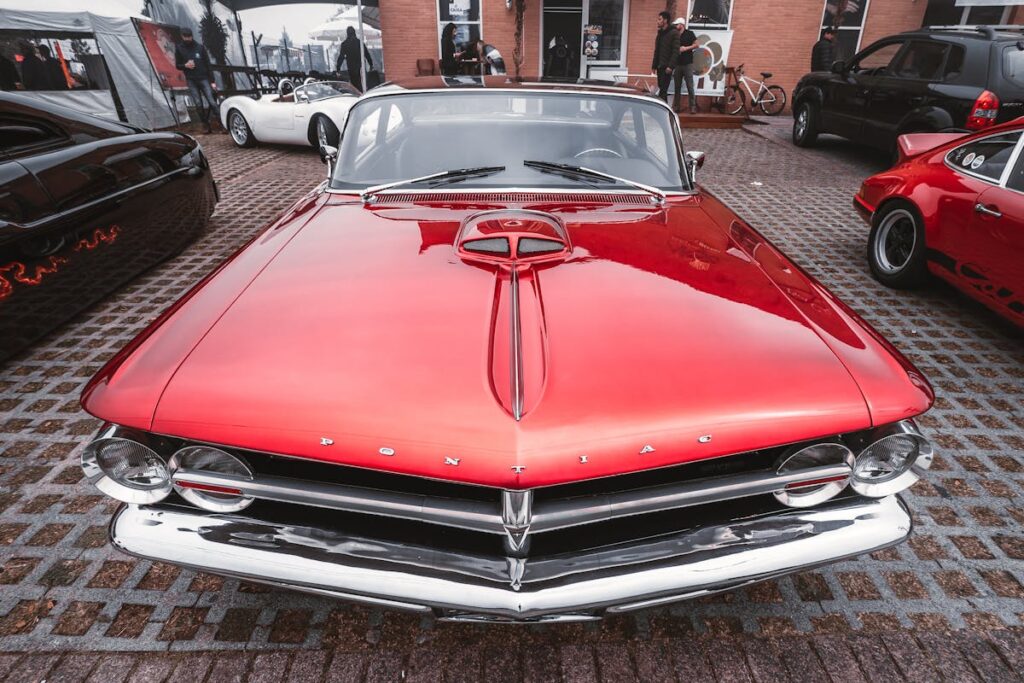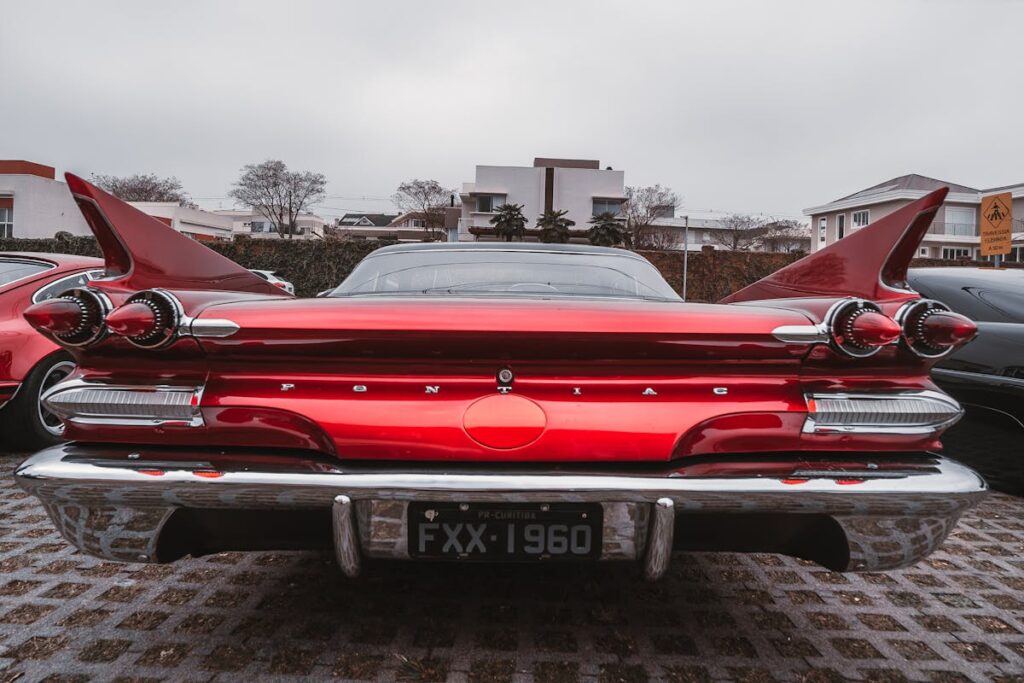The 1960s and 1970s marked a golden era in the American auto industry, introducing robust, high-performance ‘muscle cars’ that have since gained iconic status. Vehicles such as the Ford Mustang, Chevrolet Camaro, and Pontiac GTO, with their powerful V8 engines and rebellious designs, embodied an era of post-war prosperity and the thrill of speed. While these vehicles faced significant challenges, including the oil crisis and stringent emission regulations, they were able to evolve through technological advancements and continue to influence the design of contemporary automobiles. This intriguing history prompts us to further explore the legacy of these automotive marvels.
Key Takeaways
- The muscle car era emerged in the 1960s and 1970s, characterized by large V8 engines, rear-wheel drive, and aggressive designs.
- Iconic 1960s muscle cars include the Chevrolet Camaro, Ford Mustang, and Pontiac GTO, known for their power and sporty aesthetics.
- The 1970s saw advancements in muscle car design and technology, despite grappling with stricter emission standards and oil crisis.
- Collectors preserve these classic cars through careful restoration, regular maintenance, and understanding of market trends.
- The legacy of these muscle cars continues to influence modern car design, with current models maintaining the spirit of their predecessors.
Defining the Muscle Car Era
The dawn of the Muscle Car Era, a period of automotive history marked by raw power and aggressive design, came to define the 1960s and 1970s. The muscle car characteristics were unmistakable; large V8 engines, rear-wheel drive, and a focus on high-performance over luxury. These automobiles were designed for straight-line speed, embodying an attitude of rebellion and freedom that resonated with the youth of the era.
The era influences were profound, shaped by a variety of socio-economic factors. Post-war prosperity, cheap gasoline, and a booming manufacturing sector, all contributed to a demand for these high-octane powerhouses. The Muscle Car Era was also propelled by an increasingly competitive automotive industry, with each manufacturer working hard to outdo the others regarding speed, power, and styling.
In analyzing the Muscle Car Era, one must also consider the role of popular culture. Hollywood and television glamorized these vehicles, further enhancing their appeal. Yet, it was more than just glamour; these cars were symbols of individualism and personal freedom, mirroring the wider cultural shifts of the time. This era, consequently, was not only a defining moment in automotive history but also a significant part of American cultural identity.
Popular Muscle Cars of the 1960s
Delving into the 1960s, we uncover an impressive array of muscle cars that defined the decade. The Chevrolet Camaro, for instance, with its sporty design and powerful engine, embodied the spirit of American muscle cars. This vehicle, alongside the Ford Mustang, revolutionized the industry with their high-performance features and aggressive aesthetics.
The Pontiac GTO, another iconic name, was widely recognized for its robust powertrain and unparalleled acceleration. Similarly, the Dodge Charger and Plymouth Barracuda boasted exceptional speed and handling, making them a popular choice among enthusiasts.
The Mercury Cougar and Oldsmobile 442, while slightly lesser-known, still played significant roles in shaping the era. They boasted impressive horsepower and head-turning designs, contributing to the decade’s muscle car craze.
The Buick GS and AMC Javelin, despite their late arrival to the scene, offered unique design twists and performance capabilities that earned them a place in muscle car history. Last but not least, the Chrysler Road Runner, with its distinctive horn and cartoon emblem, added a touch of whimsy to this era of raw power and speed.
Iconic 1970s Muscle Cars
Shifting from the earlier years, the 1970s brought a significant evolution in muscle cars, with many iconic models entering the automotive scene. Among these, certain models stood out for their enhanced performance and power boost, marking a new era in the muscle car industry. In this section, we will explore these changes, spotlighting the top models that defined the 1970s and analyzing the technological advancements that propelled their performance.
1970s Muscle Cars Evolution
Emerging with a roar from the tumultuous 1960s, the muscle cars of the 1970s took a giant leap forward in relation to design, power, and performance. This evolution was largely influenced by the muscle car origins in the earlier decade, where manufacturers aimed to provide affordable, high-performance vehicles to the masses, particularly young, speed-hungry consumers.
In line with the racing influences that had initially sparked the muscle car phenomenon, the 1970s saw these cars becoming sleeker, more aerodynamic, and more powerful. Engines were upgraded, with many manufacturers opting for ‘big-block’ V8s, providing unprecedented power and speed.
However, this evolution was not without its challenges. The oil crisis of the 1970s and increasing environmental concerns led to stricter emission standards, which threatened the very essence of the muscle car. This resulted in an interesting dichotomy: on one hand, the muscle cars of the 1970s were becoming increasingly powerful and aesthetically appealing; on the other, they were grappling with external pressures that necessitated a decrease in fuel consumption and emissions.
Top 1970s Muscle Models
The 1970s bore witness to the introduction of some remarkable muscle cars, whose legacy reverberates to this day. The decade’s automotive industry was defined by a balance of power and style, with brands like Chevrolet, Pontiac, and Dodge dominating the muscle car market.
One such iconic model was the 1970 Chevrolet Chevelle SS 454. Its engine specifications were impressive, boasting a 450-horsepower V8 engine. This model was not only a consumer favorite but also held a strong racing heritage, being a popular choice on both the drag strip and the NASCAR circuit.
Similarly, the 1970 Pontiac GTO Judge, with its 400-cubic-inch V8 engine, was a true representation of Pontiac’s dedication to power and performance. The GTO Judge, named in homage to a popular comedy show of the time, was a bold, colorful vehicle that embodied the spirit and culture of the era.
Lastly, the 1970 Dodge Challenger R/T is worth mentioning. With its 440-cubic-inch Magnum V8 or optional 426 Hemi, it offered significant power. Its racing heritage, particularly in Trans-Am events, helped cement its status as one of the definitive muscle cars of the 1970s.
Performance and Power Boost
Building on the legacy of the iconic 1970s muscle cars, significant enhancements to their performance and power became a key focus for automakers. Engineers redefined engine specifications, achieving higher horsepower ratings and improved torque performance. Muscle cars like the Pontiac GTO and Chevrolet Chevelle boasted powerful V8 engines, delivering upwards of 400 horsepower.
The racing heritage of these vehicles led to aftermarket modifications which further magnified their power. Drivetrain enhancements, such as the addition of a limited-slip differential, were common, boosting traction and control at high speeds. Fuel efficiency was often sacrificed for power, but some automakers experimented with tuning options to strike a balance.
Suspension upgrades were frequently incorporated to handle the increased power, with additions like stiffer springs and larger sway bars. These helped to maintain stability and control, particularly when cornering at high speeds. Exhaust systems were also upgraded to accommodate the increased engine output, with larger diameter pipes and performance mufflers becoming standard.
In essence, the 1970s marked a significant era in the evolution of muscle cars, where the pursuit of performance and power took centre stage, without forgetting their racing roots.

Influential Automotive Innovations
The era of 1960s and 1970s muscle cars was not simply about raw power and speed, but also about influential automotive innovations that reshaped the industry. Pioneering design developments during this period introduced critical changes that enhanced both the performance and appeal of these vehicles. Additionally, the impact of technological advancements on these high-performance vehicles will be examined, setting the stage for how these improvements continue to influence modern automotive design and functionality.
Pioneering Design Developments
Driving forward the automotive industry, muscle cars of the 1960s and 1970s were often at the forefront of pioneering design developments and influential automotive innovations. These cars, with their audacious aesthetic appeal and powerful performance capabilities, were reflections of design influences from various eras, and engineering breakthroughs that redefined the industry’s standards.
Distinctive design influences were drawn from other successful models and even military aircraft, which led to the creation of aggressive, aerodynamic body shapes that were not only visually appealing, but also enhanced speed and performance. The bold, low-slung profiles, wide tires, and distinctive grille patterns became defining characteristics of muscle cars during this period.
Engineering breakthroughs during this era played pivotal roles in improving vehicle performance and reliability. The introduction of larger, more powerful engines, innovative suspension systems, and improved braking technology greatly enhanced the driving experience and performance capabilities of these vehicles.
Moreover, the use of lightweight materials in car construction demonstrated another pioneering design development. This reduction in weight drastically improved acceleration and speed, critical features of any muscle car.
Technological Advancements Impact
An astounding number of technological advancements during the 1960s and 1970s had a profound impact on the muscle car industry, leading to influential automotive innovations. Engine technology experienced significant evolution, with the introduction of turbocharging trends and performance upgrades. These performance enhancements not only increased the power output but also contributed to fuel efficiency, an aspect often overlooked in the era’s muscle cars.
Emission regulations introduced during this period drove the industry towards cleaner and more efficient engine technologies. This led to drivetrain advancements, particularly in the areas of transmission and differentials, that improved the overall performance of these vehicles.
Innovations weren’t limited to the engine and drivetrain; safety features saw significant enhancements, with the introduction of disk brakes, seat belts, and collapsible steering columns. Concurrently, materials innovation led to the use of lighter and stronger metals in car bodies, improving both performance and safety.
Suspension improvements also became a focal point, leading to better handling and ride comfort in muscle cars. The rudimentary computer systems of these years laid the groundwork for today’s complex vehicle management systems. These advancements illustrate the muscle car era’s substantial contribution to the automotive industry’s evolution.
Muscle Car Culture Impact
Often viewed as a symbol of freedom and power, muscle cars from the 1960s and 1970s had a profound impact on American culture. Their cultural significance was not limited to their status as high-performance vehicles; they were also a reflection of the era’s racing heritage. The muscle car phenomenon fostered community bonding, with enthusiasts gathering to showcase their vehicles, exchange technical knowledge, and engage in informal races.
The nostalgia factor of these vehicles continues to resonate today, with muscle cars frequently featuring in films and television, enhancing their iconic status and further solidifying their place in popular culture. They have influenced music, inspiring songs that celebrate speed and freedom, and have shaped fashion trends, with clothing lines designed to mirror the era’s rebellious spirit and love for the open road.
Film representation of muscle cars, from Steve McQueen’s ‘Bullitt’ Mustang to the Dodge Charger in ‘The Dukes of Hazzard’, have added to their legendary status. Regional variations in muscle car preferences reflect the diversity of American car culture, from the drag racing scenes of Southern California to the NASCAR tracks of the Southeast. The muscle car’s impact on culture is both broad and profound.
Collector’s Guide: Preserving These Classics
Preserving a classic muscle car from the 1960s or 1970s requires a detailed understanding of the vehicle’s unique characteristics and the necessary steps to maintain its performance and appearance. Restoration techniques involve meticulous attention to detail, from sourcing original or high-quality reproduction parts to guaranteeing the paint job reflects the era’s aesthetic.
Storage solutions also play an essential role in preserving these classics. Enclosed, climate-controlled environments protect the vehicle from harsh weather conditions, preserving its value. Regular maintenance tips include oil changes, tire rotations, and brake checks, which keep the car in prime condition and assure its longevity.
Value assessment of classic muscle cars involves understanding market trends. Collectors must stay updated with industry fluctuations to know when to buy, hold, or sell. Parts sourcing is another challenging aspect, as some original components may be hard to find. Community engagement through car clubs and online forums can provide valuable leads and advice.
Auction strategies are vital for collectors. High-profile auctions can drive up prices, but they can also offer rare finds. A well-informed collector understands the balance between passion for muscle cars and the financial implications of collecting, preserving, and potentially selling these classic vehicles.
Muscle Cars’ Legacy in Modern Vehicles
Drawing from the unmistakable influence of the 1960s and 1970s, today’s automotive industry continues to pay homage to the legacy of classic muscle cars. Modern interpretations of these iconic vehicles blend technology and performance with classic design elements, resulting in vehicles that are as visually striking as they are powerful.
Craftsmanship and heritage influences are evident in the current generation of muscle cars. Updated versions of the Ford Mustang, Chevrolet Camaro, and Dodge Challenger, among others, reflect their predecessors’ spirit while incorporating advanced features. Their design cues are deeply rooted in the past, with wide, low stances, aggressive lines, and engine notes reminiscent of their forebears.
These reinterpretations are not merely nostalgic throwbacks. They represent a careful balance of honoring tradition while pushing the boundaries of performance and comfort. The impact of these classic muscle cars is not limited to their modern counterparts. Their influence extends across the automotive industry, shaping the design and performance expectations of various vehicle types.
Frequently Asked Questions
What Factors Led to the Decline of the Muscle Car Era?
The decline of this era was primarily driven by stringent emissions regulations and an increasing demand for fuel efficiency. Rising insurance costs and the 1973 oil crisis also greatly impacted its downfall.
How Did Muscle Cars Influence Contemporary Car Design?
Muscle cars greatly influenced contemporary car design by inspiring performance nostalgia and design aesthetics, fostering a blend of power and style that continues to shape the industry’s approach to vehicle development and consumer appeal.
What Is the Most Expensive Muscle Car Ever Sold at Auction?
The 1971 Plymouth Hemi Cuda Convertible holds the auction record for the most expensive muscle car, fetching $3.5 million in 2014. This reflects the collector market’s high valuation of rare, vintage automobiles.
What Safety Measures Were Introduced in Muscle Cars During the 1960S and 1970S?
During the 1960s and 1970s, safety measures such as seat belts became standard. Crumple zones were also introduced, designed to absorb impact and protect passengers in the event of a collision.
Were There Any Female Designers or Engineers Involved in the Development of Muscle Cars?
While less recognized, female contributions to automotive innovation during this era were indeed present. Women like Helene Rother and Mary Barra held significant roles in design and engineering, shaping the industry’s evolution.

